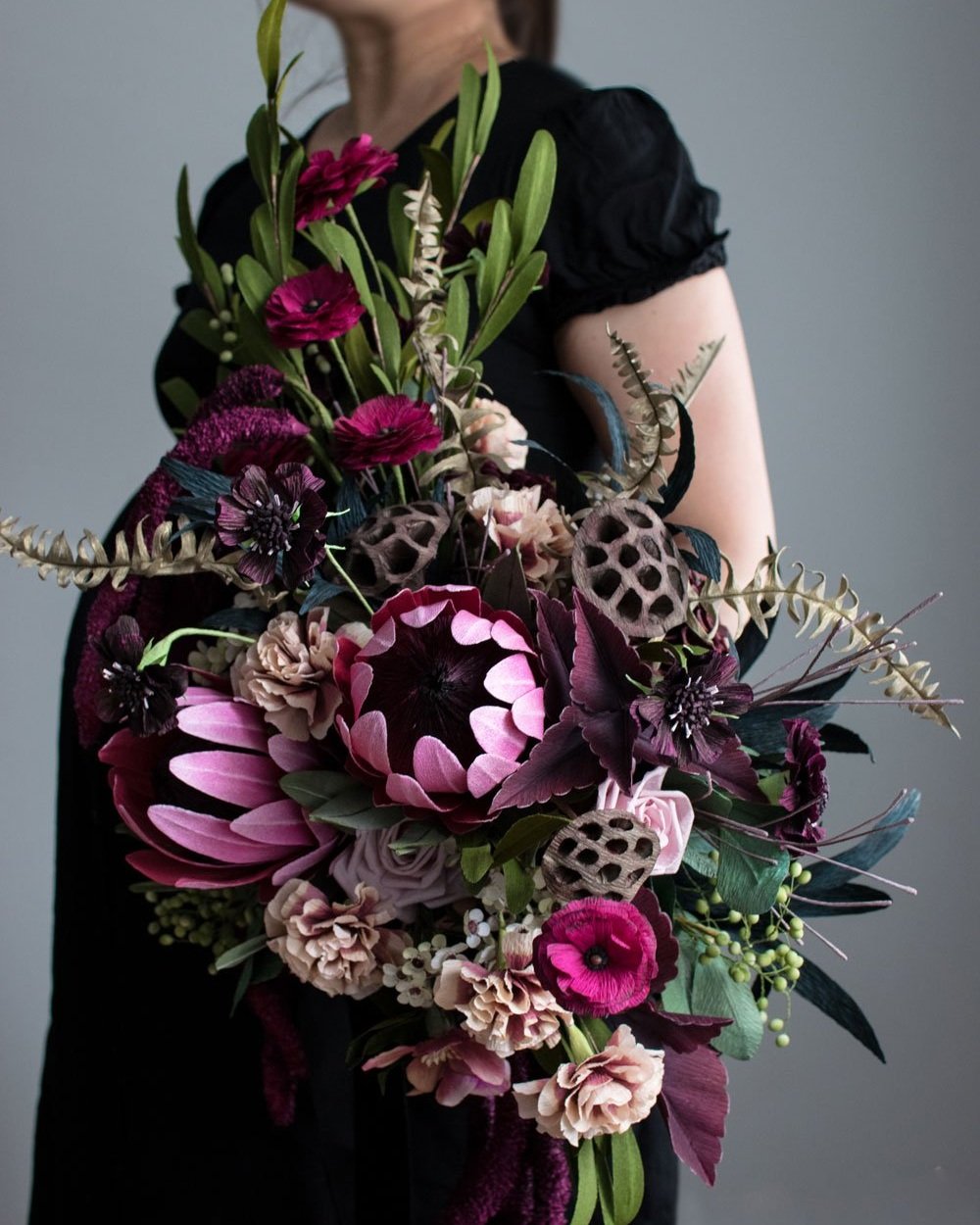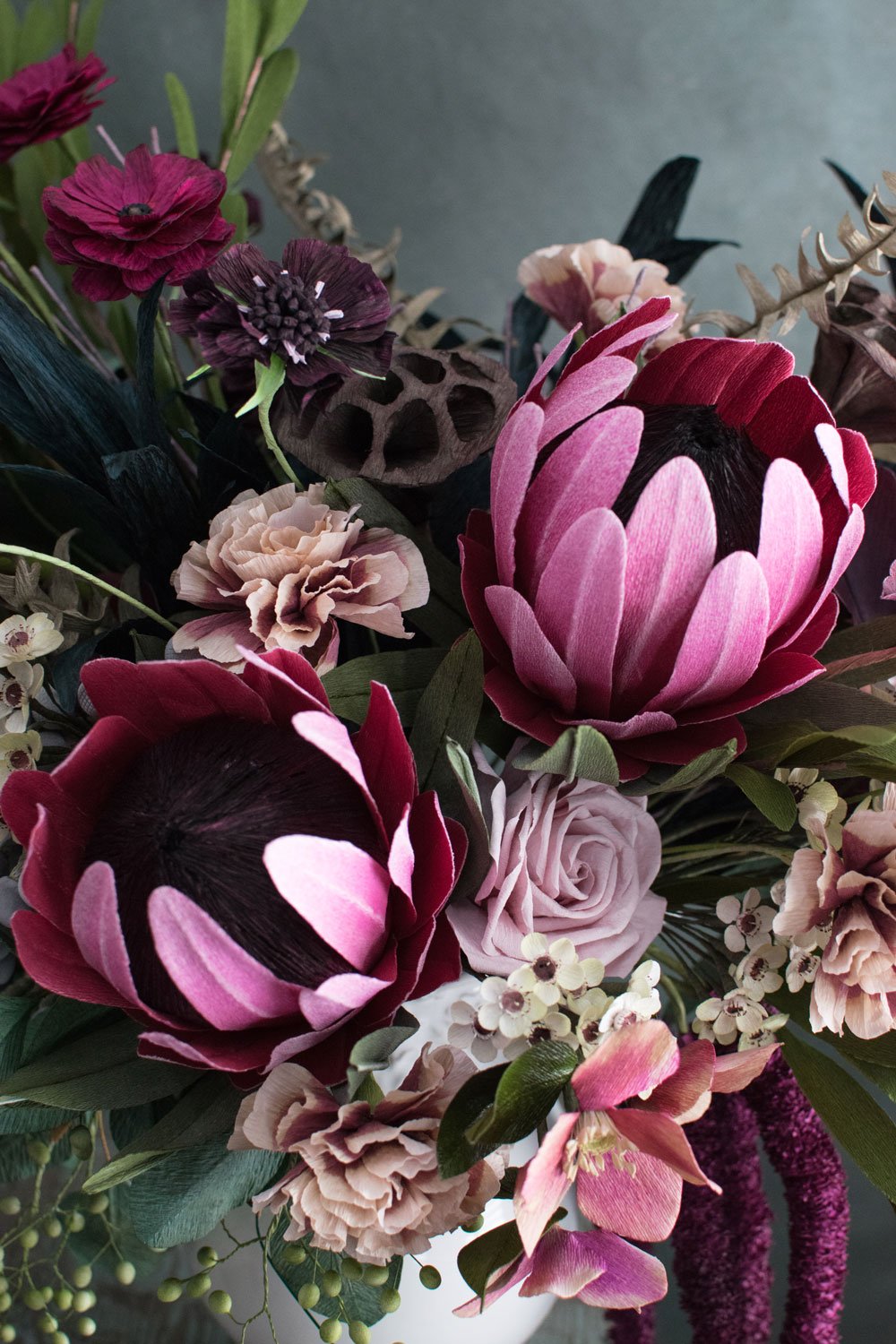Dark "Black" Paper Flower Bouquet
Disclosure - When you click on my affiliate links, I may earn a commission for qualifying purchases made through Amazon.com links in this post. This commission goes directly into the maintenance of my website, the technology that goes into my courses, and my art. Want to know more? Read my Amazon Affiliate Disclaimer.
It’s not often that a bride wants a “black” bouquet, so when my client approached me for a “black” bouquet, it Immediately piqued my interest. Her overall theme was black - her wedding dress, the groom’s suit, and the bridesmaids dresses were all going to be black. So it was up to me to convince her that a literal interpretation of a “black” bouquet would be, well too literal. For one, truly black flowers don’t exist; for another, paper flowers isn’t real so I personally feel that using black paper for paper flowers just reminds people that paper flowers aren’t real; a third reason is that black flowers against a black wedding dress just wouldn’t stand out. Luckily, my client trusted me completely. So after getting to know her personality and after some discussion of her vision for her wedding, I was confident that I knew what she would like.
This bouquet was assembled in a vase - so it can easily be displayed at the wedding or at home as an arrangement/bouquet. I usually prefer assembling my bouquets in some sort of vessel with a narrow mouth (i describe my process in my book, Paper Flower Art). However this time, I used a fancy vase and the bouquet became a stunning arrangement.
My approach to this bouquet was to create a sense of darkness and the dramatic, without it being truly black and without a ton of dark flowers. Dark flowers placed next to each other blend together too easily - their details are difficult to see by your eyes and by the camera’s lenses. A trick that impressionist artists use is to place two colours that sit opposite in the colour wheel next to each other; this contrast creates and/or emphasizes the vividness of each colour. Likewise, when you place a darker colour beside a lighter one, this contrast emphasizes how dark the burgundy is and how light the pink is. That’s why I tried to mix the dark and light coloured elements throughout the arrangement; however, because the colours lie within a similar colour spectrum - that is pinks and burgundies - you notice more of the contrast in shades (highlights/shadows) as opposed to contrast in colour.
Bouquet in vase
The most obvious way is by dividing the bouquet into dark and light sections - grouping dark coloured flowers together and light coloured flowers together. Not only does this provide more impact, it also creates movement in the arrangement by moving your eyes from dark to light. I often do this to create cohesiveness in an arrangement (as strange as it sounds) and when I can’t make up my mind of whether I want something light or dark.
I’ve always been enamoured by how florists use amaranthus to draw your eyes downwards. So I was thrilled when I finally tried my hand at making paper amaranthus and succeeded. When grouped together, they suggest a sense of visual weight like no other type of flower. I can imagine them swinging about as my bride walks down the aisle.
In addition to the amaranthus, it was a first for me trying my hand at the dried lotus seed pod, dried fern, branches, seeded eucalyptus, wax flowers and protea. In every commission, I always try to incorporate flowers or elements that I’ve never made before - it challenges my creative juices and makes the commission much more interesting to make and to look at. I absolutely do not like repeating myself or making the same bouquet over and over again! The seeded eucalyptus was very interesting because in my previous bouquet, I had made these pink pepper berries using styrofoam filler and thin wires and I just reused this technique, with slightly different positioning, for the seeds. So in a way, one technique led to another and it became a natural evolution of skills.
I also used a lot more of the Design Master sprays to colour shift. It’s so so easy and quick! Sure, it required some experimentation with colours and layering effects, but once I got the right colour, I could colour tons of paper or flowers at once. It saved me so much time compared to hand painting everything (imagine - 6 bouquets and how many stems that requires). In the end, you work with what you have, and I worked with the colours available in Canada. I used a lot of burgundy, maroon, flat black, basil, and moss green. I even used it on the pink proteas to achieve that perfect cool-pink colour that fades from the petal base to tip.
I mixed up my hellebores by making some coloured with Design Master and some coloured with alcohol inks. I actually think that hellebores are the perfect flower for both of these colouring techniques; hellebores come in “off” colours that blend and bleed into each other.
Paper Amaranthus
I’ve made scabiosas before but this time, decided to make bigger ones. I simply reused the centre technique I use for my Collerette Dahlias (from my book) in a different colour. I make my scabiosas with fairly long petals they’re not proportionate to the real thing but I like them more this way. It’s like they are wearing tutus.
Paper proteas, carnations, roses, wax flowers, hellebores, ranunculus, scabiosa, and dried lotus seed pods
For the first time, I incorporated coleus leaves in a dark burgundy colour and I absolutely love them! I used Pan Pastels to create the subtle colour variations (they have a smoky look in the centre with a lighter reddish burgundy along the edges, and white scalloped edging). The scalloped edging brought in much needed textural variation. To add bits of darkness, I made agonis in a dark black/blue using 180g Italian crepe paper in Black that had been washed and then dried.
The last piece of the pie was the antique carnation in mauve and sepia. I used 180 g Italian crepe paper in Dusky Plum and simply bleached one long edge (this technique is in my book) before cutting out petals. Deceptively easy to achieve this colour variegation with stunning results. This flower provided the perfect mid-tone colour to tie the pinks together with the brown dried elements.
The very last thing I did was wrap a black velvet ribbon around each bouquet letting the ends hang long a bit. I thought it would be the perfect textural contrast to the paper flowers and my client’s sequin wedding dress.
Paper proteas, carnations, roses, wax flowers, hellebores, ranunculus, scabiosa, and dried lotus seed pods
Bridal bouquet





